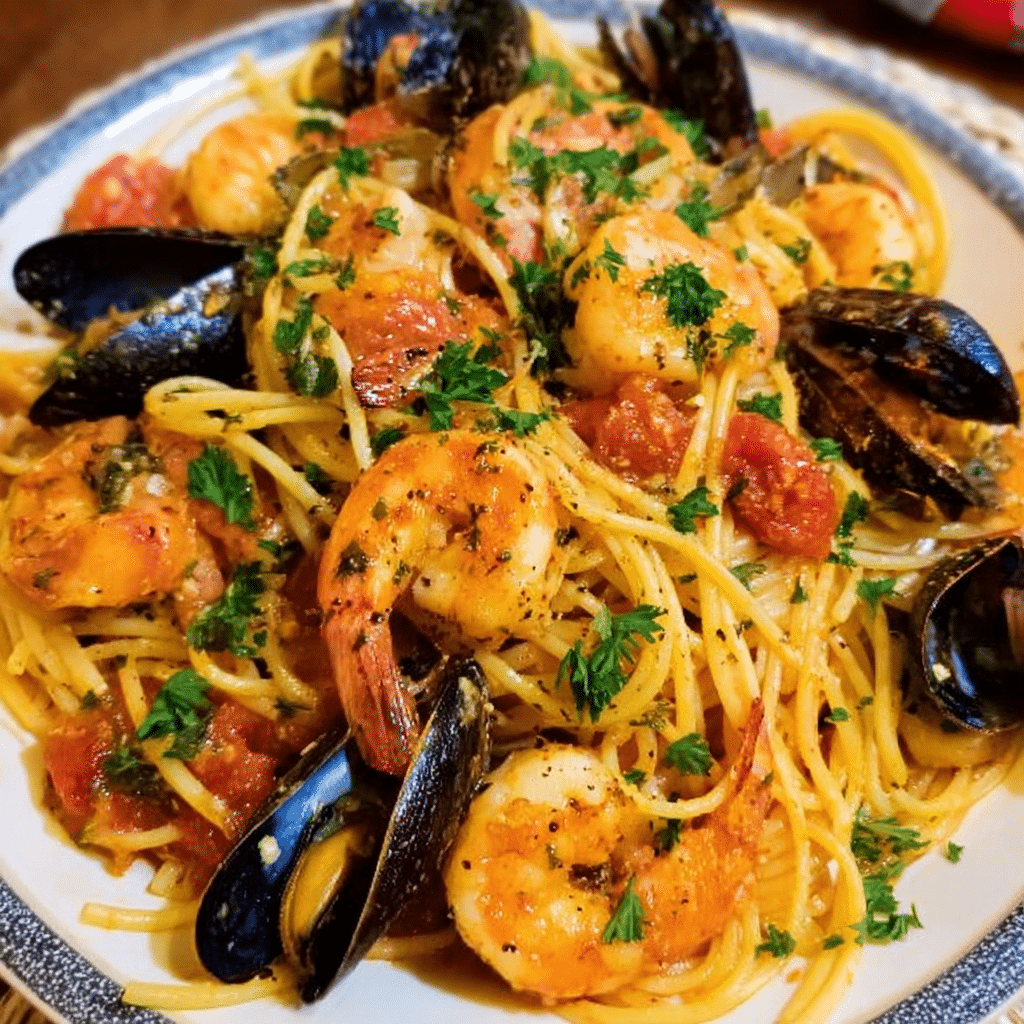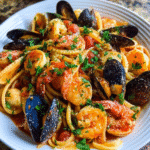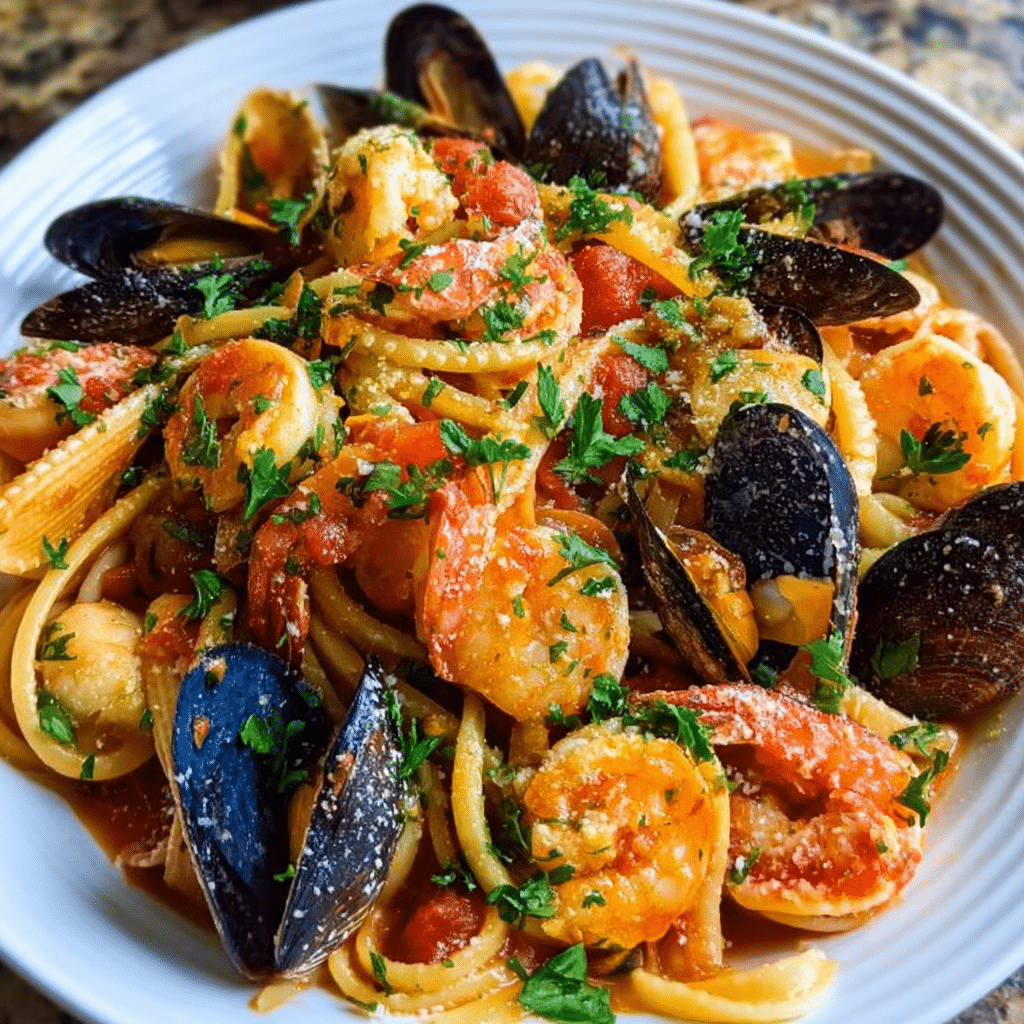Seafood pasta those two words alone can transport you to a coastal Italian trattoria, where the sea meets your plate in the most delicious way. But let’s be honest: how many times have you attempted a seafood dish at home only to end up with rubbery shrimp or overcooked mussels? I’ve been there, and I know how frustrating it can be.
That’s exactly why I created this seafood pasta recipe. It promises restaurant-quality results with just 5 minutes of prep time yes, you read that right. The shrimp stay tender, the mussels open perfectly, and the pasta is kissed with garlic, lemon, and fresh herbs in a way that makes every bite memorable.
I’m Emeli, and cooking has been my language of love for as long as I can remember. From my earliest days scrambling eggs in my childhood kitchen to training in professional kitchens and exploring street markets around the globe, I’ve learned that the magic of great food lies in its simplicity. At FoodFansy, I’m all about sharing recipes that are easy to follow but rich in flavor dishes that bring people together without keeping you chained to the stove.
In this guide, I’ll walk you through everything you need to know: how to choose the freshest seafood, foolproof cooking techniques, timing tips to avoid overcooking, and plenty of variations to make this dish your own. Whether you’re cooking for a weeknight dinner or impressing guests on the weekend, this seafood pasta has you covered.
Why This Seafood Pasta Recipe Works
This isn’t just another pasta recipe it’s a carefully balanced combination of fresh ingredients, smart timing, and minimal fuss. Here’s what makes it stand out:
- Lightning-fast prep: With only 5 minutes of prep work, you can have this dish ready in under 30 minutes total. Perfect for busy weeknights when you crave something special.
- Fresh, accessible ingredients: You don’t need exotic seafood or hard-to-find items. Shrimp, mussels, and scallops are available at most grocery stores and fish markets.
- One-pan magic: Everything comes together in a single large pan, which means less cleanup and more time enjoying your meal.
- Flexible and forgiving: Whether you’re a beginner or an experienced cook, this recipe gives you room to adjust flavors and swap ingredients based on what you have on hand.
- Restaurant-quality results: The combination of garlic, lemon, fresh parsley, and reserved pasta water creates a light, silky sauce that clings to every strand of pasta and piece of seafood.
Choosing the Right Seafood for Seafood Pasta
The success of your seafood pasta starts at the market. Fresh, high-quality seafood makes all the difference between a mediocre dish and one that transports you straight to the Mediterranean coast.
Best Seafood for This Recipe
For this recipe, I recommend using a combination of shrimp, mussels, and scallops. Each brings its own unique texture and flavor:
- Shrimp: Choose medium to large shrimp (16-20 count per pound) for the best bite. They cook quickly and add a sweet, delicate flavor.
- Mussels: These bivalves steam open beautifully in the pan, releasing their briny liquor that enriches the sauce. Look for mussels with tightly closed shells.
- Scallops: Sea scallops are ideal for their buttery texture and ability to develop a golden crust when seared properly.
Buying Tips for Seafood Pasta
Shopping for seafood can feel intimidating, but a few simple guidelines will help you select the freshest catch:
- Smell test: Fresh seafood should smell like the ocean clean and briny, never fishy or ammonia-like.
- Visual cues: Shrimp should be firm and translucent. Mussels and other shellfish should have intact, closed shells (or shells that close when tapped).
- Ask questions: Don’t hesitate to ask your fishmonger when the seafood arrived and what they recommend. They’re your best resource for quality and freshness.
- Buy from trusted sources: Whether it’s a dedicated fish market or the seafood counter at your grocery store, establish a relationship with vendors who prioritize freshness.
Seafood Substitutions for Seafood Pasta
One of the beauties of this recipe is its flexibility. If you can’t find all three types of seafood or if you prefer certain varieties here are some great swaps:
- No scallops? Use squid rings or even chunks of firm white fish like cod or halibut.
- Prefer clams? Swap mussels for littleneck clams; they’ll steam open just as beautifully.
- All shrimp version: You can make this dish with shrimp alone just increase the quantity to about one pound.
- Lobster luxury: For a special occasion, add lobster tail meat for an extra-decadent touch.
Ingredients & Prep for Seafood Pasta
Let’s talk about what you’ll need to bring this dish to life. The ingredient list is refreshingly short, but each component plays an important role.
Seafood Prep Essentials for Seafood Pasta
Proper preparation ensures your seafood cooks evenly and tastes incredible:
- Clean mussels thoroughly: Rinse them under cold running water and scrub away any debris. Remove the “beard” (the fibrous threads) by pulling it firmly toward the hinge of the shell. Discard any mussels with cracked shells or ones that won’t close when tapped.
- Pat shrimp dry: Use paper towels to remove excess moisture from the shrimp. This helps them sear rather than steam. Season lightly with salt and pepper just before cooking.
- Scallop prep: If your scallops have the small side muscle still attached, gently pull it off. Pat them completely dry for the best sear.
Pantry Staples You’ll Need for Seafood Pasta
The supporting cast of ingredients creates the aromatic base and bright finish:
- Olive oil: Use a good-quality extra virgin olive oil for sautéing. It carries the flavors of garlic and onion beautifully.
- Garlic: Fresh garlic cloves, minced or thinly sliced, provide that classic aromatic foundation.
- Onion: A small yellow or white onion, finely chopped, adds sweetness and depth.
- Lemon juice: Freshly squeezed lemon brightens the dish and cuts through the richness of the seafood.
- Fresh parsley: Roughly chopped Italian flat-leaf parsley adds color, freshness, and a subtle herbal note.
- Pasta: Spaghetti, linguine, or fettuccine all work wonderfully. Choose your favorite long pasta shape.
- Salt and pepper: For seasoning throughout the cooking process.

Step-by-Step Cooking Instructions for Seafood Pasta
Now for the fun part let’s cook! Follow these steps for perfectly cooked seafood pasta every single time.
Pre-Cooking Prep for Seafood Pasta
Setting yourself up for success starts with proper prep work:
- Cook the pasta: Bring a large pot of salted water to a rolling boil. Add your pasta and cook according to package directions until al dente (usually 8-10 minutes). Before draining, reserve at least ½ cup of the starchy pasta water this liquid gold will help create a silky sauce later.
- Prep your aromatics: While the pasta cooks, mince 4-5 garlic cloves, finely chop one small onion, and roughly chop a generous handful of fresh parsley. Having everything ready before you start cooking ensures smooth execution.
- Organize your seafood: Arrange your cleaned mussels, dried shrimp, and scallops on a plate near the stove. Season the shrimp lightly with salt and pepper.
Cooking Method for Seafood Pasta
With everything prepped, the actual cooking happens quickly:
- Heat the pan: Place a large, wide pan (a deep sauté pan or shallow Dutch oven works perfectly) over medium-high heat. Add 3-4 tablespoons of olive oil and let it shimmer.
- Build the aromatic base: Add the chopped onion and cook for 2-3 minutes until it begins to soften and turn golden. Add the minced garlic and cook for another 30 seconds, stirring constantly to prevent burning. The kitchen should smell absolutely incredible at this point.
- Cook the seafood: Add the shrimp, mussels, and scallops to the pan. Stir gently to coat everything in the garlicky oil. The shrimp will begin to turn pink within 2-3 minutes. The mussels will start to open as they steam. The scallops should develop a golden crust on each side resist the urge to move them too much.
- Combine with pasta: Once the seafood is nearly cooked, add your drained pasta directly to the pan. Pour in the reserved pasta water and a generous squeeze of fresh lemon juice (about 2 tablespoons). Toss everything together, allowing the pasta to absorb the flavors and the sauce to come together. The starchy pasta water will emulsify with the oil, creating a light, clingy sauce.
- Finish with herbs: Remove the pan from heat and toss in the fresh parsley. Give everything one final toss to distribute the herbs evenly.
Doneness Check for Seafood Pasta
Knowing when your seafood is perfectly cooked prevents the dreaded rubbery texture:
- Shrimp: They should be completely opaque with a pink-orange color. They’ll curl into a loose “C” shape. If they curl tightly into an “O,” they’re overcooked.
- Mussels: The shells should be fully opened. Discard any mussels that remain closed after cooking they weren’t alive to begin with.
- Scallops: Look for a golden-brown sear on both sides while the center remains slightly translucent. They should feel firm but springy to the touch, not hard.
Resting Seafood Pasta
This step might seem unusual for pasta, but it makes a real difference:
Let the pasta rest in the pan for about 2 minutes off the heat before serving. This allows the flavors to meld together beautifully, and the pasta will continue to absorb the aromatic sauce. During this time, the dish settles into perfect harmony each element supporting the others.
Pro Tips for Perfect Seafood Pasta
After years of making seafood pasta in various kitchens, I’ve learned some tricks that elevate this dish from good to extraordinary.
Avoiding Rubbery or Overcooked Seafood Pasta
The most common mistake with seafood is overcooking, which turns tender proteins into rubber bands:
- Don’t overcrowd the pan: If your pan isn’t large enough for all the seafood in a single layer, cook in batches. Overcrowding causes steaming rather than searing.
- Watch the clock: Seafood cooks incredibly fast. Shrimp takes 2-3 minutes, scallops need about 2 minutes per side, and mussels open in 3-5 minutes.
- Remove promptly: As soon as the seafood is cooked, either remove it from the pan temporarily or turn off the heat. Residual heat will continue cooking.
- Add a splash of white wine: For extra flavor and moisture, deglaze the pan with ¼ cup of white wine after cooking the aromatics but before adding the seafood.
Tool Recommendations for Seafood Pasta
Having the right equipment makes this recipe even easier:
- Large, wide pan: A 12-inch or larger sauté pan gives you room to cook everything without overcrowding.
- Pasta pot with strainer insert: Makes it easy to scoop out pasta water before draining.
- Kitchen timer: Seafood timing is crucial, so set reminders.
- Quality tongs: Essential for tossing pasta and seafood together without breaking delicate pieces.
- Sharp knife: For efficient prep work with garlic, onions, and parsley.
Storage & Reheating Seafood Pasta
While seafood pasta is best enjoyed fresh, you can store and reheat leftovers:
- Refrigerate: Store in an airtight container for up to 2 days. Note that seafood texture changes slightly when reheated.
- Gentle reheating: Warm leftovers in a pan over low heat with a splash of water or broth to revive the sauce. Microwave on 50% power in short intervals.
- Freezing: I don’t recommend freezing seafood pasta, as the texture of cooked seafood deteriorates significantly when frozen and thawed.
- Fresh is best: This dish takes so little time to make that I always recommend preparing it fresh rather than relying on leftovers.
Flavor Variations for Seafood Pasta
One of my favorite things about this recipe is how easily it adapts to different flavor profiles and dietary needs.
Spicy Twist for Seafood Pasta
If you love heat, there are several ways to add a fiery kick:
- Red pepper flakes: Add ½ to 1 teaspoon when sautéing the garlic for a classic Italian fra diavolo style.
- Fresh chilies: Finely chop a jalapeño or serrano pepper and cook with the onions.
- Calabrian chili paste: Stir in a spoonful for deep, smoky heat with fruity undertones.
- Cayenne pepper: Just a pinch adds warmth without overwhelming the delicate seafood flavors.
Keto/Paleo Seafood Pasta Options
For those following low-carb or grain-free diets, this recipe adapts beautifully:
- Zucchini noodles: Spiralize zucchini as a pasta substitute. Add them at the very end and toss just until warmed through to prevent mushiness.
- Spaghetti squash: Roast the squash ahead of time and use the strands in place of pasta.
- Kelp noodles: These neutral-flavored noodles work well for a very low-carb option.
- Cauliflower rice: For a completely different take, serve the seafood over cauliflower rice instead of pasta.
Global Flavors for Seafood Pasta
Take your seafood pasta on a culinary journey with these international twists:
- Spanish-inspired: Add smoked paprika, saffron, and a handful of cherry tomatoes for a paella-like experience.
- Thai-style: Replace the lemon with lime, add fish sauce, coconut milk, and fresh basil for Southeast Asian flair.
- Mexican coastal: Incorporate chipotle peppers, cilantro, and a squeeze of lime with a touch of cumin.
- French Provençal: Add white wine, fresh tarragon, fennel, and a touch of butter for an elegant French preparation.
Seafood Pasta Flavor Variations Table
| Variation | Key Ingredients | Best Pasta Choice | Cooking Adjustment |
|---|---|---|---|
| Classic Italian | Garlic, lemon, parsley, olive oil | Spaghetti or linguine | Follow base recipe |
| Spicy Fra Diavolo | Red pepper flakes, crushed tomatoes, red wine | Linguine | Add tomatoes after garlic; simmer 5 min |
| Creamy Alfredo Style | Heavy cream, Parmesan, butter | Fettuccine | Add cream after seafood; reduce 2 min |
| Spanish Paella-Style | Saffron, paprika, cherry tomatoes, peas | Short pasta or orzo | Add tomatoes early; use white wine |
| Thai Coconut | Coconut milk, fish sauce, lime, basil | Rice noodles | Replace olive oil with coconut oil |
| Keto Zucchini Noodles | Same as classic, skip pasta | Spiralized zucchini | Add zoodles last; don’t overcook |
Serving Suggestions for Seafood Pasta
The right accompaniments turn this seafood pasta from a simple meal into a complete dining experience.
Perfect side dishes: Keep sides light to let the seafood shine. A crisp green salad with lemon vinaigrette, crusty Italian bread for soaking up sauce, or roasted asparagus with garlic make excellent companions. Roasted cherry tomatoes on the vine add color and a sweet-tart contrast.
Wine pairings: A chilled white wine complements seafood beautifully. Try a crisp Pinot Grigio, which won’t overpower the delicate flavors, or a Sauvignon Blanc with its bright acidity. For something special, a Vermentino or Albariño echoes the coastal Mediterranean vibe. If you prefer red, go with a light-bodied Pinot Noir served slightly chilled.
Beer pairings: A light lager or pilsner works wonderfully, as does a Belgian-style wheat beer with notes of citrus. Avoid heavy, hoppy beers that compete with the seafood.
Presentation tips: Serve the pasta in shallow bowls to showcase the beautiful seafood. Arrange a few mussels in their shells on top for visual appeal. Finish with a drizzle of high-quality olive oil, a crack of black pepper, and a lemon wedge on the side. Garnish with extra parsley for a pop of color.
Family-style serving: For a casual gathering, bring the whole pan to the table and let everyone serve themselves. There’s something wonderfully communal about sharing a big pan of pasta with loved ones.
FAQs About Seafood Pasta
Over the years, I’ve received countless questions about making seafood pasta. Here are the answers to the most common ones:
Can I use frozen seafood for seafood pasta?
Yes, but with some caveats. Thaw frozen seafood completely in the refrigerator overnight before cooking. Pat it extra dry to remove excess moisture, which can prevent proper searing. Frozen seafood won’t have quite the same sweet, fresh flavor as fresh varieties, but it’s still a convenient option. Never cook seafood directly from frozen in this recipe it will release too much water and steam rather than sear.
How do I fix overcooked seafood in my pasta?
Unfortunately, once seafood is overcooked and rubbery, there’s no way to reverse it. However, you can minimize the texture issue by chopping the overcooked seafood into smaller pieces and mixing it thoroughly with the pasta and sauce. The flavors will still be delicious, even if the texture isn’t perfect. The best fix is prevention watch your cooking times carefully and remove seafood from heat as soon as it’s done.
Is this seafood pasta recipe safe for pregnant women?
Pregnant women should only eat seafood that’s been thoroughly cooked to a safe internal temperature. The shrimp, mussels, and scallops in this recipe should all be cooked until fully opaque with no translucent centers. Avoid any mussels that don’t open during cooking. Pregnant women should also ensure their seafood comes from reputable sources and avoid high-mercury fish. When prepared correctly with fully cooked seafood, this dish can be enjoyed during pregnancy. However, always consult with your healthcare provider about your specific dietary needs.
Can I make this recipe ahead of time?
Seafood pasta is really best made fresh, as seafood doesn’t reheat particularly well. However, you can prep components ahead: clean your seafood and store it covered in the refrigerator, chop your aromatics and keep them in airtight containers, and cook your pasta slightly underdone, then finish it when you’re ready to serve. The actual cooking only takes about 15 minutes, so it’s manageable even on busy evenings.
What if my mussels don’t open?
Discard any mussels that remain closed after cooking. They were likely dead before cooking and shouldn’t be eaten. Before cooking, also discard any mussels with cracked shells or ones that don’t close when tapped. Fresh, live mussels will always open when properly steamed.
Can I add vegetables to this seafood pasta?
Absolutely! Cherry tomatoes, baby spinach, bell peppers, and zucchini all work beautifully. Add heartier vegetables like peppers with the onions. Quick-cooking vegetables like spinach or halved cherry tomatoes can go in during the last minute or two of cooking.
Conclusion
There’s something magical about a plate of perfectly cooked seafood pasta the way the flavors of the ocean mingle with garlic, lemon, and fresh herbs, how the pasta captures every bit of that aromatic sauce, and how it all comes together in less time than it takes to watch your favorite show.
This recipe proves that restaurant-quality food doesn’t require professional training or hours in the kitchen. With just 5 minutes of prep work, fresh ingredients, and a little attention to timing, you can create something truly special.
So fire up your stove, grab the freshest seafood you can find, and give this recipe a try tonight. Whether you’re cooking for yourself on a Tuesday evening or hosting friends for a weekend dinner, this seafood pasta delivers every single time.
If you enjoyed this recipe, be sure to share it with your friends or save it for later! I’d love to see your unique twist feel free to post your photos on Pinterest!
Print
Seafood Pasta – 5-Minute Prep, Delicious & Easy Recipe
- Total Time: 30 minutes
- Yield: 4 servings 1x
Description
Seafood Pasta with shrimp, mussels, and scallops tossed in garlic, olive oil, and fresh parsley for a comforting yet elegant meal.
Ingredients
200g spaghetti or linguine
200g shrimp, peeled & deveined
150g mussels, cleaned
100g scallops
3 tbsp olive oil
3 garlic cloves, minced
1 onion, chopped
2 tbsp lemon juice
Salt & pepper to taste
Fresh parsley, chopped
Instructions
1. Cook pasta until al dente and reserve pasta water.
2. Heat olive oil, sauté garlic and onion.
3. Add shrimp, mussels, and scallops, cook until done.
4. Toss pasta with seafood, pasta water, and lemon juice.
5. Garnish with parsley and serve hot.
Notes
Tip: Always reserve pasta water for silky sauce.
Seafood should be cooked quickly to avoid toughness.
- Prep Time: 10 minutes
- Cook Time: 20 minutes
- Category: Dinner
- Method: Stovetop
- Cuisine: Mediterranean
Nutrition
- Serving Size: 1 bowl
- Calories: 420
- Sugar: 3g
- Sodium: 480mg
- Fat: 12g
- Saturated Fat: 2g
- Unsaturated Fat: 8g
- Trans Fat: 0g
- Carbohydrates: 55g
- Fiber: 4g
- Protein: 24g
- Cholesterol: 95mg
Keywords: Seafood Pasta, easy pasta recipe, shrimp pasta

